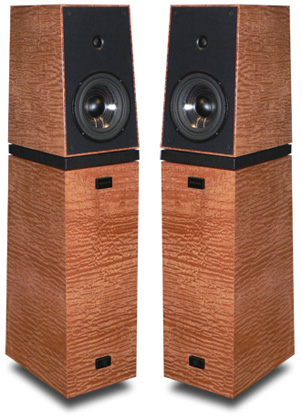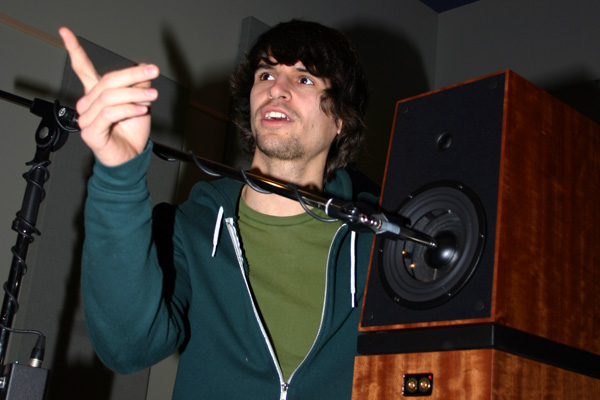 |
|
| December 15, 2007 Searching for the Extreme: An In-Depth Look at the Verity Audio Rienzi
The genesis of the Rienzi was the idea of building a speaker that would bridge the gap between the Tamino X2 and the Fidelio. The two-cabinet Tamino was discontinued a while back, and Verity believed that the gap between the fairly compact, two-way Tamino X2 and the Fidelio was a bit too wide for the continuity the company wanted to maintain throughout its line. At 39.0"H x 8.6"W x 13.0"D, the Rienzi is only slightly smaller than the Fidelio, and only a little larger than a minimonitor on a stand. The Rienzi was originally conceived as a single box, but because the large panels that would have been required proved too difficult to damp, the Verity design team decided to divide the box into two. As an additional benefit of the two-box approach, Verity netted themselves a new, lower-priced monitor speaker to replace the original Tamino. When powered separately from the bass module, the Rienzi monitor is a full-range two-way; placed atop the bass module and wired through it via the supplied jumpers, the midrange driver is filtered at the bottom of its range via a 150Hz first-order high-pass crossover. As a speaker in the middle of the Verity line, the Rienzi received drivers from models both above and below. The 6.5" midrange driver is similar to that used in the Tamino X2. Sourced from SEAS, this driver’s cone is made of TPX, which, Verity claims, is one of the lightest polymers in the world, and combines excellent absorption qualities with high internal damping. TPX is a thermoplastic resin, which means that it can be formed by thermal molding. Running the midrange driver without a low-pass crossover has become a Verity hallmark. The midrange plays up to the top of its mechanical abilities, at which point it begins to roll off naturally. This has several advantages, most notably permitting a higher high-pass crossover point for the tweeter (i.e., the tweeter’s range doesn’t have to extend too low), thereby increasing the tweeter’s power handling. Additionally, Verity’s penchant for running the midrange up to its mechanical limit keeps the crossover point out of the range where the ear is most sensitive: the "presence region," or 3-5kHz. However, compromises are inherent in this approach. Asking a 6.5" midrange to play up to 4.5kHz, at which point the tweeter kicks in and the midrange rolls off, means that the midrange will most certainly beam. That is, it won’t produce as much output off axis at high frequencies as it will on axis, and less high-frequency sound will reach the listener’s ears via reflections from room boundaries, which in turn will cause a dip in the speaker’s overall upper-midrange response. Being savvy speaker designers, the Verity team considered this issue, and concluded that keeping the crossover out of the presence region is more important than an even off-axis frequency response. Verity’s Julien Pelchat is enthusiastic about the Rienzi’s 3/4" soft-dome tweeter, which is made by Scan-Speak. "We’ve used this tweeter in the Tamino and the Fidelio," he says. "It was designed by one of the same guys who started Audiotechnology, and it’s been in production for years. Every time they decide to try to replace it with a new version, they end up preferring the old one." Whereas the Fidelio and Parsifal Ovation monitors are separated from their bass modules by an aluminum plate with Sorbothane pucks on both sides, the Rienzi’s constrained-layer damping sandwich has a center layer of MDF. While the use of a wooden platform obviously helps keep the costs down, Pelchat wanted to make it clear that, in Verity’s exhaustive listening tests, MDF also sounded the best. Since the very first iteration of the Parsifal, Verity speakers have had rear-facing woofers. They’ve also had reversible binding posts so that, should a room’s configuration demand it, the speakers can be installed facing forward. But the optimum configuration, the one that the speaker was designed to be used in, is with the woofers facing toward the rear. This way, the woofer faces a corner defined by three planes: the floor and two walls. While it’s not an exact analogy, the woofer gains some efficiency because, in a way, it’s horn loaded. (I’ve taken advantage of this effect for years in my cars, pointing the subwoofer toward the rear of the car, thus netting a few extra dB of bass volume -- and, surprisingly, extension.) This way, Verity is able to get the Rienzi -- and all of its speakers that feature dedicated woofers -- to output more bass with less (claimed) distortion than comparable speakers with front-firing woofers. And because the woofer faces away from the listener, and since midrange frequencies are directional, the upper extremes of its frequency range roll off with a higher apparent crossover slope than a front-firing driver.
As I noted in my listening evaluation, the Rienzi proved an absolutely fabulous match with the Song Audio SA-300MB triode monoblocks. On the face of it, you might well think that the 87dB-sensitive Rienzi would prove too inefficient for the Song Audios. According to Verity, the Rienzi is a true 8-ohm speaker with a minimum impedance of 6 ohms; it’s this easy impedance that’s probably responsible for the speaker’s superb performance with these sometimes-finicky amplifiers. Although the Rienzi is the second model from the bottom of the Verity line, it’s still a luxury product. Verity’s trademark aluminum flight cases are options, and the company hasn’t scrimped on the Rienzi’s construction or finish. Rienzis are made in the same shop as Verity’s top models, and veneered and lacquered with the same care. The cabinet itself isn’t the last word in density, but according to Verity it’s braced according to Golden Ratio proportions and built to the same standards as the rest of the company’s line. Any number of companies manufacture several distinct models within their speaker lines, but these often display wildly different finishes, components, overall quality standards, and, most important, sound quality. Verity has taken a different path. There’s a definite feeling of continuous integrity in their product line, each speaker showing the clear signs of the significant amounts of time, effort, and love that have gone into each stage of its creation. The kind of painstaking care that Verity puts into its products doesn’t come cheap. The Rienzi is not inexpensive at $8795 USD per pair, but it’s also not cheaply built. It’s a beautifully engineered and crafted product that will continue to seduce its owner long after the check has cleared. ...Jason Thorpe
Ultra Audio is part of the SoundStage! Network. |
 Verity Audio makes careful choices. The
company’s inaugural product is still in production -- no doubt in a significantly
improved form -- and is immediately recognizable to anyone who ever laid eyes on the
original. But Verity has grown, and as it’s matured, the company has introduced one
carefully engineered product after another. The result is now a full line of speakers, all
of which employ the core technologies found in that very first model, the Parsifal. With
their latest speaker, the Rienzi, Verity’s goal was to deliver a large dose of the
Parsifal’s performance at a significantly lower price.
Verity Audio makes careful choices. The
company’s inaugural product is still in production -- no doubt in a significantly
improved form -- and is immediately recognizable to anyone who ever laid eyes on the
original. But Verity has grown, and as it’s matured, the company has introduced one
carefully engineered product after another. The result is now a full line of speakers, all
of which employ the core technologies found in that very first model, the Parsifal. With
their latest speaker, the Rienzi, Verity’s goal was to deliver a large dose of the
Parsifal’s performance at a significantly lower price.